ABOUT THE C.G. JUNG FOUNDATION
Newsletter of the C.G. Jung Foundation of Ontario
ISSN 1918-6142
Chiron is a newsletter that exists to support the work of the C.G. Jung Foundation of Ontario. It was established in 1980, and has existed in electronic form since 2006. Its name and masthead image, adopted at that time, are drawn from ancient Greek culture. In Greek mythology, Chiron was the last centaur, a son of the titan Cronus. He was famed for his wisdom, knowledge and skill at deciphering the will of the gods, to healing effect.
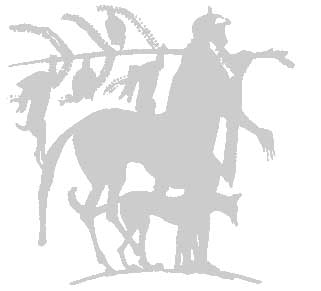
Volume 33, No. 1 Autumn 2013
Editor: Robert Black
| PDF version of this issue for easier printing |
Contents
- New Programme Year
- Visiting the new Office & Library
- Three New Analysts
- The Jesus of History and the Christ of Faith: A Psychological Perspective
- Culling the Library
- The Hermes Bowl
- Report on the “Farewell to 223” event
- Submissions to Chiron
NEW PROGRAMME YEAR
The new public education programme was off to a good start with analyst Mary Tomlinson’s talk, “What Is It About A Mystery? Why Detective Stories Hold Us In Their Thrall,” which came out of her pleasure in discovering in Zurich that she and Jung shared a delight in reading mystery stories.
There remain a number of offerings to attract you. Please ring for a copy of our brochure, or visit the Foundation website at http://www.cgjungontario.com/ to see what else is in store for this year.
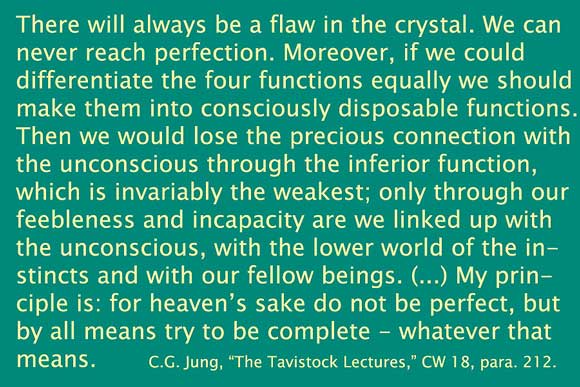
Visiting the new Office & Library
Here is an image of part of the new space we are occupying at the Arts & Letters Club of Toronto, downtown on Elm Street near the Dundas subway stop.
Catherine Johnson, our friendly and hard-working administrator, has been working hard to get it set up, and is happy to welcome visitors to the Arts & Letters Club, 14 Elm Street, on our usual Thursday “open office” day.
Please be prepared for the fact that in deepest, darkest downtown, the entry procedure seems a bit formidable. Prepare mentally for the fact that it doesn’t seem like a very personal welcome, at least at first! You’ll need to push the white button, situated to the left of the front door. You will then be viewed through a security camera above it. You will either be “buzzed in” by the Club’s office staff from upstairs, or by a Club member in the vicinity of the door. Since they will not know you, you will need to identify that you wish to go downstairs to the Jung Foundation.
The office is situated down a very few stairs right inside the front door. At the bottom, you turn to your left, and then immediately go left again. You’ll see an antechamber with a small table holding that familiar acrylic container full of our Public Education Programme brochure, and the office door opposite will be open during office hours.
Three New Jungian Analysts
At a ceremony on September 21, 2013, a Diploma in Analytical Psychology was presented to each of Donna Morrison-Reed, Matthew Kelly, and Peggy Voth. This conveys membership in the “voting society” which conferred it (OAJA), and that in turn brings membership in the venerable organization started by C.G. Jung, the International Association of Analytical Psychology.
19. DONNA MORRISON-REED 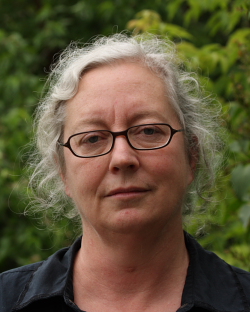
Born in Ottawa, Donna grew up in Toronto and Montreal. During the 1970s she received a B.A. (History) from McGill and then moved to Chicago to complete an M.A. (Divinity) at the University of Chicago and a Doctor of Ministry degree at Meadville/Lombard Theological School. From 1979 until 2005 she and her husband raised two children while serving as Unitarian Universalist parish ministers – for ten years in Rochester NY followed by sixteen years in Toronto.
During the summer of 2005, Donna’s world took a complete change in direction. She and her husband both left the ministry. In June they sold their house, in August their youngest child moved to Michigan, and in September Donna began the Analyst Training Program. Over the next five year she and her husband led a wandering, homeless existence as Donna worked her way through the opus of Jung. A change of underwear, a couple of T-shirts, a pen, a notebook, a cup of coffee in the morning and the next volume of the Collected Works were all she held on to as she slowly put herself back together. Five years into the program Donna moved into a new home and began seeing clients. Today she is very happy to have graduated from a program that transformed her life.
Donna is a patron of Child Haven International, an organization that serves children and women in developing countries who are in need of food, education, health care, shelter and clothing. She is a “closet” violinist and has helped build schools, visited children’s homes and backpacked in many parts of the world. Her thesis analyzed Hesiod’s Theogony, the oldest surviving poem in the Greek language. Exploring the archetypal elements of the text, she sought to uncover the visceral, preverbal experience of identity emergence and formation.
20. MATT KELLY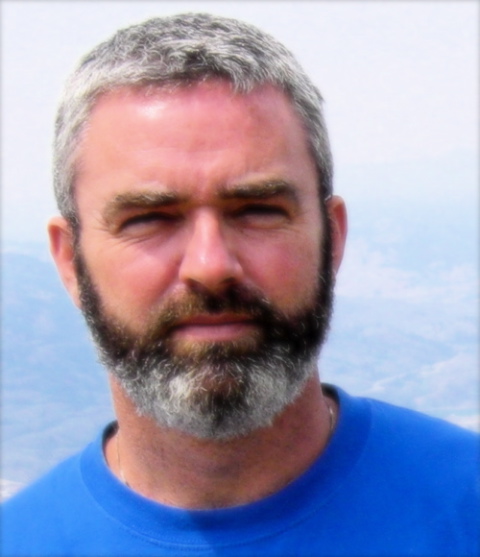
Matt sends greetings to all, and says that he is thrilled to be a graduate of the OAJA analyst training programme. Unable to afford studying in the hallowed grounds of Zurich, he found that the prima materia of Hogtown enabled him to assimilate more shadow and mana than he might have otherwise! His thesis is entitled, "The Dragon and the Green Man: From Symptom to Symbol in PTSD Recovery."
Matt is a former teacher of gifted and troubled youth, with degrees in philosophy, education and comparative religion. He has training in Arnold Mindell's process psychology, Waldorf education and men's archetypal work. He has studied and taught in Haida Gwaii and Vancouver BC, Guelph ON, Ann Arbor MI, Sumatra, India, Tibet and Japan. He maintains a practice on the east side of Toronto.
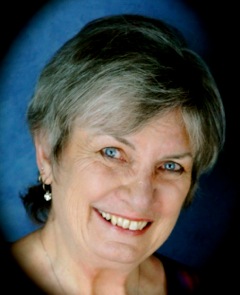 21. PEGGY VOTH
21. PEGGY VOTH
Peggy sees the Self having a hand in her becoming an analyst. During a year of monthly solitary retreats, her unconscious came unleashed and she felt she needed help. A friend gave her the name of someone who “works professionally with dreams.” Completely ignorant about what she was getting into, Peggy set up an appointment. Over time, she found out that she was in Jungian analysis.
Three years later, at the prodding of dreams and visions from the inner world and doors closing in the outer world, Peggy entered the OAJA Analyst Training Programme. Looking back over her life, she can now see that she was headed to this point of being a Jungian analyst all along.
Earthrise: Symbol, Culture and the Individual is the title of Peggy’s thesis. Joseph Campbell described the “Earthrise photograph” – sent back to Earth from Apollo 8 on Christmas Eve 1968 – as “the most powerful image in the mythological imagination ... the first time Earth was able to look back on itself through the eyes it had grown in human beings.” The thesis explores the influence of that image on the collective of Peggy’s homeland (the U.S.) and the role of personal individuation in cultural advancement.
Married with two grown sons and a grandchild, Peggy lives in Calgary, Alberta, where she has practiced as a clinical social worker for twenty years. Her growth through analysis surpassed all she had hoped for, and she is pleased to bring the depth of Jungian psychology to her work.
The Jesus of History and the Christ of Faith: A Psychological Perspective
by Schuyler Brown, University of Toronto
Although this paper was given in the public programme of the C.G. Jung Foundation of Ontario, I have deliberately not subtitled it a Jungian Perspective. I am not at all sure that Jung was interested in the question. He writes:
Since Christ never meant more to me than what I could understand of him, and since this understanding coincides with my empirical knowledge of the self, I have to admit that I mean the self in dealing with the idea of Christ. As a matter of fact I have no other access to Christ but the self, and since I do not know anything beyond the self I cling to his archetype. I say, “Here is the living and perceptible archetype which has been projected upon the man Jesus or has historically manifested itself in him. If this collective archetype had not been associated with Jesus he would have remained a nameless Zaddik.” (CW18, para. 1669)
Jung’s indifference to the historical Jesus reminds me of Bultmann, but what lies behind his indifference is totally different. Bultmann had no interest in a knowledge of Jesus “according to the flesh”(cf. 2 Cor 5:16) because, for him, Jesus is only the presupposition for the Christian kerygma, not a part of it. A faith which depends on a historical foundation is no longer faith.
For Jung, however, it is the archetype which is important, not the person on whom the archetype is projected or in whom it has historically been manifested. Jung’s indifference is psychologically, not theologically, motivated.
Jung and Bultmann not withstanding, in 1969 Neill Hamilton proclaimed, “There is no God, and Jesus is his Son” (Jesus for a No-God World). For Jewish scholars of the New Testament, Jesus is part of their history but not of their faith. But for some of those who remain affected by the Christian tradition, even in this post-Christian environment, the numinosum has moved from Christ to Jesus. It is a curious fact that in our secular society the figure of Jesus still exercises an irresistible attraction over theists and nontheists alike. Many today are disappointed with established institutions, whether political, social or religious. Jesus appeals to them because his life was a struggle to the death against the religious and political establishments of his day. Furthermore, he was a poor, uneducated representative of a people whose country was occupied by a foreign power.
Walter Wink (The Human Being) is an example of this move to place Jesus where the Deity used to be. His inspiration comes from Feuerbach, who rejected all belief in transcendence and regarded the human being as the true ens realissimum. Humankind’s alienation from itself reflects the unrealized intimacy of consciousness we have yet to bridge, because we have yet to become fully human ourselves. Wink sees Jesus’ message as a liberation from bondage to the Powers that Be (Romans 13:1), through accession to full humanity.
There is a danger in this fascination with the historical Jesus: in trying to encounter Jesus in the world in which he lived, we may unconsciously be molding him in our own image and likeness. Psychologists call this ”projection,” and it is particularly likely to occur in the case of a figure who exercises such numinosity that, in the minds of some, he has made the Deity superfluous.
Harnack sought to penetrate through centuries of dogmatic accretions and so to recover the historical Jesus, but “the Christ that Harnack sees, looking back through nineteen centuries of Catholic darkness, is only the reflection of a Liberal Protestant face, seen at the bottom of a deep well” (Christianity at the Crossroads, p. 44). Evidence of projection is no less evident today. In his 1994 review of The Five Gospels, a book which came out of the Jesus Seminar, Reginald Fuller observes, “The fellows of the seminar in their search for the historical Jesus see the reflection of the counter-culturalism of an aged hippy.”
Projection is but one of many threats to scholarly objectivity. According to E.H. Carr,
When we call a historian objective we mean I think two things. First of all, we mean that he has the capacity to rise above the limited vision of his own situation in society and in history, a capacity which, as I suggested in an earlier lecture, is partly dependent on his capacity to recognize the extent of his involvement in that situation, to recognize, that is, the impossibility of total objectivity. Secondly, we mean that he has the capacity to project his vision into the future in such a way as to give him a more profound and lasting insight into the past than can be attained by those historians whose outlook is entirely bounded by their own immediate situation” (What is History?, p. 123).
In the lecture that I gave each year on “The Jesus of History and the Christ of Faith” in the Introduction to the New Testament course which all students entering the Toronto School of Theology were obliged to take, I made it my practice to say, “History will not bring you into the Kingdom of God, but it may help keep you honest.”
I decided to present a paper to a Jungian audience on a subject in which neither Jung nor most Jungians show much interest. Why? Because I think that Jungian indifference to history brings Jungian psychology into disrepute. It is not just the origins of Christianity in which most Jungians have little interest.
Psychoanalysis continues to exhibit an unconscionable disregard for its own history. No other contemporary intellectual endeavor, from conventional biomedical research to literary criticism suffers from so profound a lack of a critical historical sense concerning its origins.” (A Most Dangerous Method, p.14)
Bultmann’s dogmatic skepticism is now pretty much a thing of the past. Dominic Crossan is of much greater interest these days. But in the Jungian camp, Hal Childs moves from Jung’s indifference to the Jesus quest to its impossibility. Bultmann made exactly the same move (“Nicht sein kann was nicht sein darf.”) The title of Childs’ book (The Myth of the Historical Jesus) tells it all: he equates history with mythology. Although Childs is writing about Jesus, this equation would bar any access to the past, the one capability, as far as we know, that distinguishes homo sapiens from other species. Childs cites with approval Nietzsche’s dictum, “There are no facts, only interpretations.” Are all interpretations equally deserving of attention or of no attention? Childs would lead us unto “a night in which all cows are black” (Hegel).
To be sure, von Ranke’s “wie es eigentlich gewesen” implies a reality for the past which the past does not possess; only the present is real. But although the past does not exist, there are traces of the past which do exist: memory, written documents, archeological remains. From these traces the historian seeks to reconstruct, or better, to construct a facsimile of what may have been. Pace Childs, the past, and Jesus of Nazareth in particular, is not a closed book, as Childs would clearly like it be.
The Greek word historia (Ionic: ἱστορία, historie) means “inquiry” (Liddell and Scott, p. 842). It occurs in Herodotus but not in the New Testament. However, the cognate verb does occur, in the context of Paul’s first visit to Jerusalem, the purpose of which was “to inquire of Cephas,” i.e. Peter. Paul does not tell us what they talked about, but it would seem likely that Jesus was part of the conversation. Perhaps it was the knowledge of Jesus “according to the flesh” derived from this visit that Paul later decided he could do without (2 Cor. 5:16).
Our topic and the issue it raises go back to a work by Martin Kaehler, Der sogenannte historische Jesus und der geschichtliche, biblische Christus (1892). Are history and faith parallel lines which never meet? Roger Haight’s important book, Jesus, Symbol of God (1999), proposes a symbolization of Jesus which accords with the view of Jung cited above. But I do not see the transformation of a historical person into a symbol as an answer to Kaehler’s dichotomy. Of course, Haight was not writing with Kaehler in mind.
Jerome Bernstein originated the term “borderland consciousness” to describe the psychic space where the “overly rational western ego is in the process of reconnecting with its split-off roots in nature.” Perhaps we might add “its split-off roots in religion.” This space can be represented figuratively as the area where two circles intersect (the mandorla). Paul attributes his apostleship to an experience designated by one Greek word: ὤφθη , ophthe (1 Cor. 15:8). This is an experience which we today would call paranormal, and although Paul implies that he was the last to receive it, there is nothing in the Greek word itself to require this.
When we dream or have fantasies of wild animals, plants or unleashed elemental forces, we are stepping into that realm of the psyche. In the area where the two circles intersect Western rationalism is trumped by an experience of expanded consciousness which, in the Christian tradition, is called faith. In the ophthe experience Jesus becomes the Christ.
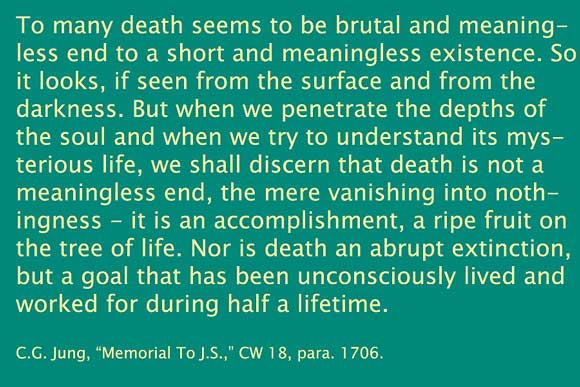
Culling the Library
The fact of a move away from 223 St. Clair Avenue West, and the harder reality of limited space in our new location, meant that a serious culling of our book collection had to be undertaken.
The current librarian, Mary Tomlinson, assisted by the former one, Robert Black, met with Catherine Johnson early in the summer to discuss the principles by which we would reduce the volume of the Fraser Boa Library. We did raise and consider the thought that, in a world of eReaders and Kindles, electronic reading media seem slowly to be replacing physical books. But our conclusion was that the physical delight of holding an actual book, and the symbolic or emotional value of holding a visible, tangible library in our central office, outweighed any concerns that we might here be on the wrong side of history!
Once it was decided to dispense with most duplicates of Jungian books – the exception being most-often-borrowed materials – it was logical to be fairly rigorous in disposing of “second tier,” mass market and non-Jungian books, particularly those that (according to the borrowing slip in the library-pocket) had never been borrowed. Audio-visual material contained in old technologies (reel-to-reel tapes, cassettes, and VHS) were also culled, but in most cases the material is still available in CD and DVD formats.
Of course we do not intend thereby dishonour Freud and Frankl and all the others! But the needs of the non-voting membership, plus the candidates in training and analyst-members, requires us to concentrate chiefly on the writings of C.G. Jung himself, other works of Analytical and Archetypal psychology, and the post-Jungian writings.
As most of our readers know, the old space had a decent sized room dedicated to housing most of our collection (the audio-visual collection and equipment being kept elsewhere). The new space has brand new, stout white shelves to fit with the office decor, but much less space to accommodate a collection that had grown up somewhat idiosyncratically over three decades.
No count was made of the books, journals, magazines, and old-fashioned taped materials that were released to our membership and to various college book sales. It was probably in the neighhbourhood of a thousand to thirteen hundred volumes, or less than half of our old collection. A last-minute decision to ask for the donation of a dollar a book, at the “Farewell to 223” event, was received as a bit of an ambush, so to be fair not much (perhaps about a hundred dollars) was received from that source. Not being entrepreneurs or police, those responsible receive any blame, if it is to be laid.
The Hermes Bowl
Recently we heard of a cute and more merciful version of the “job jar” idea, which seems to us to have a certain Mercurial quality.
Instead of a jar containing only ghastly repair and housework tasks that must be done , a container is filled with identical long slips of paper, rolled up and closed so as to seem identical but also to be cheat-proof. Each assigns one activity – some jobs to be sure (clean the refrigerator!), but also some play (go to the R.O.M.!), some unexpected (give something beautiful away!), some easily physical (go for a long walk!), and none expensive – for random selection as needed. Or (for ever-busy people) at a fixed time, such as the start of each quarter (or month, or week).
So sit with these slips and your friends or partner or family to compose these “possibilities,” and then when the right moment comes, draw a “scroll” and obey! One never knows what energy may flow, and new connections, internal or external, may result.
Report on the “Farewell to 223” event
On June 8, 2013, about 50 people gathered for wine and nibbles at our former premises of 223 St. Clair Avenue, Third Floor. The immediate draw was release of unneeded books and AV materials from our library. The main beneficiaries, we are happy to say, were students, many of them members of the C.G. Jung Society at the University of Toronto.
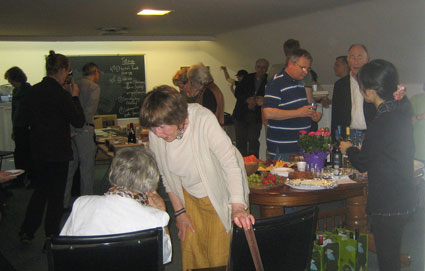
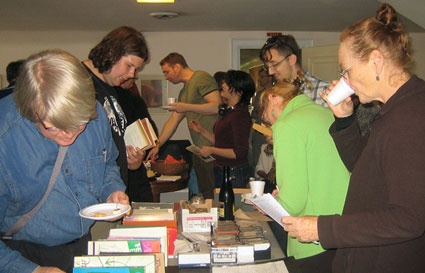
Photo credit: Edith Leslie
Amid the cabinets which had been emptied and the dozens of boxes which had been packed by the intrepid Catherine Johnson and her volunteers, members took advantage of the opportunity to browse, nibble, sip and then reminisce about activities and personalities that had filled our old “digs,” ending with analyst Caroline Duetz conducting a smudging ritual to empty the space in less tangible ways.
Analyst Jean Conon Unda had organized the festivities, and as analyst Caroline Duetz noted after, “It was really good with lots of great energy and anecdotes. The food looked fabulous! It felt like a very fitting way to end our long history with this space. It has served us very well – the gods have been kind to us in the past and now going into the future in our new location.”
All in all, sad though it has been to move, we believe that we honoured the location of so much growth and discussion and discovery during the last thirty or so years. And we believe that the move has been a Good Thing for us.
So now, onwards!
SUBMISSIONS TO CHIRON
The C.G. Jung Foundation’s members and friends are very welcome to submit pieces for publication in Chiron. We would particularly welcome short articles (under 1000 words) on archetypal material, and very short (under 500 words) “book notes” and film reviews. Longer pieces can be negotiated, especially if serialization is possible.
We very sincerely promise that our responsibility to cast an eagle editorial eye over these submissions will be lightly and not impertinently applied, and that you will see beforehand any results of our meddling; so that the full essence of your insights and the character of your “voice” is kept safe and sound in the published version.
Hyperlinks in the electronic version of Chiron
Hyperlinks in the electronic version of Chiron do not imply or constitute endorsement of the organization or individual concerned, and are provided as a courtesy in current issues only. The C.G. Jung Foundation of Ontario is not responsible for the content of such sites.
Past issues available online
- Spring 2013
- Autumn 2012
- Spring 2012
- Winter 2012
- Autumn 2011
- Summer 2011
- Spring 2011
- Winter 2011
- Autumn 2010
- Summer 2010
- April 2010
- January 2010
- October 2009
- Summer 2009
- April 2009
- December 2008
- January 2007
- September 2006